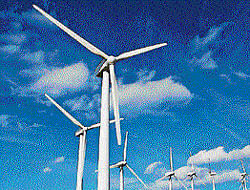
Wastelands in Karnataka can generate at least 50,000 MW of wind energy with turbines fitted at a height of 80 metres, according to a study by the Center for Study of Science, Technology and Policy (CSTEP).
The study report released on Wednesday also identified Haveri, Chikkaballapur, Hassan, Bijapur and Kolar districts, apart from Bellary, Chamarajnagar and Chitradurga, for having the potential for generation of wind energy.
Even if five per cent of the wind-rich agricultural lands are made use of to install turbines, 20,000 MW of wind power can be generated. Similarly, Andhra Pradesh has an estimated potential of 88,000 MW on wastelands and additional 12,000 MW, if five per cent of the agricultural lands suitable for wind power was used, the study said.
Alok Srivastava, Joint Secretary, Union Ministry of New and Renewable Energy (MNRE who released the report on Wednesday, said both Karnataka and Andhra Pradesh have larger scope to tap wind potential.
“With more turbines and increased wind power generation in place, Karnataka and Andhra Pradesh governments can install an inter-state power grid, which can support power demands in the entire South India,” he said.
Srivastava said the zones with wind potential, identified in the report, have many advantages.
“Because these are wastelands, clearances for wind projects would be easier and big wind farms can be set up. Also, there is scope for other industries to have their plants adjoining these zones, as there is assured power source for them,” he said.
S V Ranganath, Chief Secretary, Government of Karnataka, said the country can no more be dependent on scarce resources like coal.
Policies
“The need of the hour is to adopt forward-looking policies. The report is more authentic as Geographical Information System (GIS) has been used to map out wastelands as well as to identify areas rich in wind potential. Scrub forest lands are another area, where we can tap wind energy efficiently,” he added.
The report also lists out the possible policy implications of the study and highlights that high capacity turbines in these lands coupled with expedited clearances would be beneficial to Karnataka.
Also, keeping in mind the lack of uniformity in wind generation throughout the country, the report suggests the firming of inter-state transmission capacity as well as better planning and co-ordination between departments to ensure that extra energy generated in the State can be sold to other states.
Offshore wind energy
Srivastava said they have still a long way to act upon the route to tap the offshore wind energy in the country.
“A sub-committee appointed to look into the scope for off shore wind energy generation has submitted its report in September 2012, and it is under the review of the MNRE,” he said.
Srivastava said if one needs to install a wind turbine on a sea shore, there were at least 18 different government agencies from whom he or she needs to get clearances.
“Also, we need to address issues such as coastal security, missile testing, defence, flight paths along with petroleum or natural gas exploration. Drafting a policy to tap shore wind energy itself is little complex and a single window agency for obtaining all such clearances needs to be established,” he said.